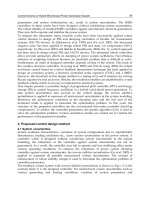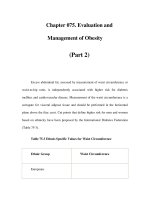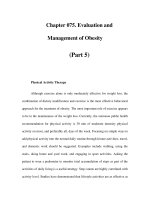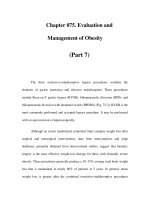Chapter 104. Acute and Chronic Myeloid Leukemia (Part 7) pot
Bạn đang xem bản rút gọn của tài liệu. Xem và tải ngay bản đầy đủ của tài liệu tại đây (65 KB, 5 trang )
Chapter 104. Acute and Chronic
Myeloid Leukemia
(Part 7)
Acute Myeloid Leukemia: Treatment
Treatment of the newly diagnosed patient with AML is usually divided into
two phases, induction and postremission management (Fig. 104-2). The initial
goal is to quickly induce CR. Once CR is obtained, further therapy must be used to
prolong survival and achieve cure. The initial induction treatment and subsequent
postremission therapy are often chosen based on the patient's age. The influence of
intensifying therapy with traditional chemotherapy agents such as cytarabine and
anthracyclines in younger patients (<60 years) appears to increase the cure rate of
AML. In older patients the benefit of intensive therapy is controversial; novel
therapies are being pursued.
Figure 104-2
Flow chart for the therapy of newly diagnosed acute myeloid leukemia.
For all forms of AML except acute promyelocytic leukemia (APL), standard
therapy includes a 7-day continuous infusion of cytarabine (100–200 mg/m
2
per
day) and a 3-day course of daunorubicin (45–60 mg/m
2
per day) or idarubicin
(12–13 mg/m
2
per day) with or without 3 days of etoposide. Patients who achieve
complete remission undergo p
ostremission consolidation therapy, including
sequential courses of high-
dose cytarabine, autologous stem cell transplant (SCT),
high-
dose combination chemotherapy with allogeneic SCT, or novel therapies,
based on their predicted risk of relapse (i.e., risk-
stratified therapy). Patients with
APL usually receive tretinoin together with anthracycline chemotherapy for
remission induction and then consolidation chemotherapy (daunorubicin)
followed by maintenance tretinoin, with or without chemotherapy. The role
of
cytarabine in APL induction and consolidation is controversial.
Induction Chemotherapy
The most commonly used CR induction regimens (for patients other than
those with APL) consist of combination chemotherapy with cytarabine and an
anthracycline. Cytarabine is a cell cycle S-phase–specific antimetabolite that
becomes phosphorylated intracellularly to an active triphosphate form that
interferes with DNA synthesis. Anthracyclines are DNA intercalaters. Their
primary mode of action is thought to be inhibition of topoisomerase II, leading to
DNA breaks. Cytarabine is usually administered as a continuous intravenous
infusion for 7 days. Anthracycline therapy generally consists of daunorubicin
intravenously on days 1, 2, and 3 (the 7 and 3 regimen). Treatment with idarubicin
for 3 days in conjunction with cytarabine by 7-day continuous infusion is at least
as effective and may be superior to daunorubicin in younger patients. The addition
of etoposide may improve the CR duration.
After induction chemotherapy, the bone marrow is examined to determine
if the leukemia has been eliminated. If ≥5% blasts exist with ≥20% cellularity, the
patient is usually re-treated with cytarabine and an anthracycline in doses similar
to those given initially, but for 5 and 2 days, respectively. Our recommendation,
however, is to change therapy in this setting. Patients who fail to attain CR after
two induction courses should immediately proceed to an allogeneic stem cell
transplant (SCT) if an appropriate donor exists. This approach is only applied to
patients under the age of 70 with acceptable end-organ function.
With the 7 and 3 cytarabine/daunorubicin regimen outlined above, 65–75%
of adults with de novo AML under the age of 60 years achieve CR. Two-thirds
achieve CR after a single course of therapy, and one-third require two courses.
About 50% of patients who do not achieve CR have a drug-resistant leukemia, and
50% do not achieve CR because of fatal complications of bone marrow aplasia or
impaired recovery of normal stem cells. Higher induction treatment–related
mortality and frequency of resistant disease have been observed with increasing
age and in patients with prior hematologic disorders (MDS or myeloproliferative
syndromes) or chemotherapy treatment for another malignancy.
High-dose cytarabine-based regimens have very high CR rates after a single
cycle of therapy. When given in high doses, more cytarabine may enter the cells,
saturate the cytarabine-inactivating enzymes, and increase the intracellular levels
of 1-β-D-arabinofuranylcytosine-triphosphate, the active metabolite incorporated
into DNA. Thus, higher doses of cytarabine may increase the inhibition of DNA
synthesis and thereby overcome resistance to standard-dose cytarabine. In two
randomized studies, high-dose cytarabine with an anthracycline produced CR rates
similar to those achieved with standard 7 and 3 regimens. However, the CR
duration was longer after high-dose cytarabine than after standard-dose cytarabine.









